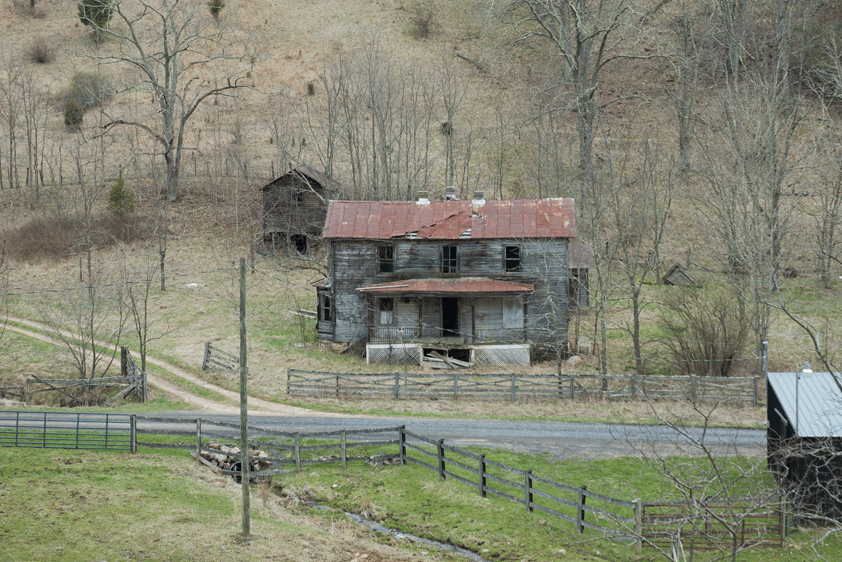ARCHITECTURAL GHOSTS OF VIRGINA #01
/All that remains of a post-civil war rural cabin up behind my house in Charlottesville, Virginia.
Every since I arrived in Charlottesville, Virginia in 2004, I’ve spent a great deal of time exploring the back roads, searching out places on my motorcycle that are new to me, and that are often accessible only by four-wheel-drive vehicles or motorcycles like mine. I have a few BMW “Dual Sport” bikes that are built to handle off road conditions, but that also do just fine on the pavement. I’ll probably never exhaust the seemingly endless quantity of fire roads, logging trails, dirt, and partially paved roads that have etched their way across the mountains and through the valleys a day’s ride from Charlottesville, which is just to the east of the Blue Ridge Mountain in west central Virginia. A long day ride west takes me across the Blue Ridge and the Shenandoah Valley out into the Allegheny Mountains and home again. This part of the western edge of Virginia and into West Virginia is the very heart of what is known as Appalachia. Here time seems to have stood still, and the architectural ghosts of Virginia and West Virginia abound.
There are small towns and villages that have their structures, and these can be quite beautiful, unusual, and intriguing, but I’m particularly attracted to the buildings living and deceased that appear in the most remote, lonely, and inhospitable places imaginable out beyond the town limits. These are the hardscrabble places, where life must have been almost unbearable at times, but also sublimely beautiful. It’s a heartbreaking balance. The places I find appear today much as they would have in the 18th, 19th, and early 20th centuries, and that makes the experience of discovery even richer. There is very little to bring the modern visitor into the present.
In this part of my Architectural Blog, I’ll share with you some of what I find, and let you know how you can find these places should you choose to go exploring yourself. You can always contact me for more exacting directions, I’m happy to oblige. But don’t wait too long. Much of what I’ll show here won’t last much longer. These places are deteriorating as I write this. Wood and brick dissolve relatively slowly, but as every year passes, there is less to see of the buildings, and the trees and undergrowth will soon engulf them completely, making them even harder to locate. Luckily, the remains of the old roads usually pass close by these places; to live further out would have been suicidal for the early inhabitants.
Read on for an introduction to Architectural Ghost #1:
ARCHITECTURAL GHOST #1
Farmhouse and Outbuildings looking west from route 624, near McDowell, Virginia
Farmhouse and Outbuilding looking northwest from route 624
Corner of Farmhouse looking southwest from route 624
Farmhouse looking west from route 624
I came upon this once beautiful 19th century farm on a ride from the town of McDowell, which is Highland County, Virginia, west of Staunton on route 250, and just east of the town of Monterey. Heading north and west of McDowell up into Jack Mountain on Jack Mountain Road will bring you to this farm, first viewed from up above as you wind down on the road that passes right between the farmhouse and the barn. This is an amazingly charming setting, one of the more serene and tranquil that I’ve found. The house is a common form found throughout Virginia, basically a center entrance “two over two” rectangle, with an added Ell off the back, and a side bay. The farmer’s porch along the front may have been added later. A pair of chimneys flank the center entrance hall and stair, providing heat to each of the four main rooms. The Ell contains the Kitchen, its chimney can be seen poking through the roof.
Farmhouse showing Ell and pair of Outbuildings looking south on route 624
The rubble stone foundation is largely intact, and the standing seam metal roof has struggled to keep out the rain, but is losing the battle. This is one of those places that teeter on the brink of being able to be saved, but the cost of doing so at this point would be prohibitive for all but the most dedicated and deep-pocketed restorer. No doubt it will continue to dissolve until only the chimney and foundation walls remain. The barn is still in service to someone, and has been maintained to some extent, but the house and the two small sheds behind it have been abandoned to the elements.
Farmhouse and Outbuildings to the right, Barn to the left, looking south on route 624







